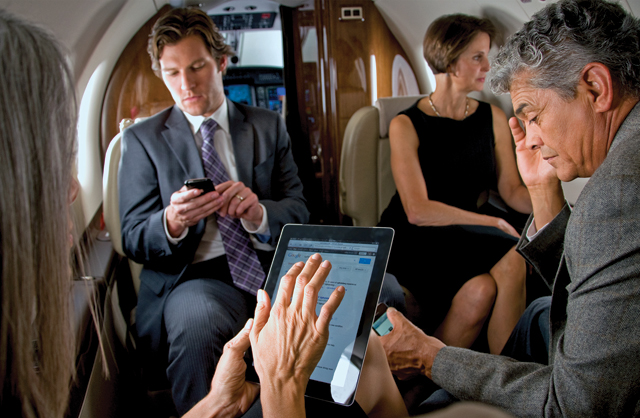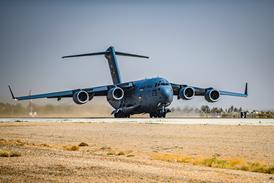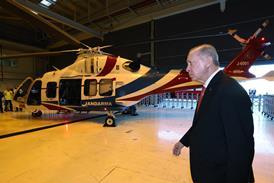Connectivity, both in the cabin and in the cockpit, has become a must-have item in business aviation. The proliferation of personal electronic devices such as smartphones and tablet computers has led to an expectation to be connected to the Internet at all times, whether on the ground or in the air.
As a result, in-flight connectivity providers are experiencing strong demand for their products and services, many of which they will be showcasing or launching at the European Business Aviation Convention and Exhibition (EBACE) this month.
“Broadband is rapidly becoming as important to aircraft as engines,” says Gogo Business Aviation executive vice-president and general manager John Wade. The US-based in-flight connectivity provider, which rebranded its former Aircell business aviation division last September, is planning to launch its Text & Talk service for the European market at EBACE after introducing it to its home market in 2013.
Text & Talk enables passengers to use their own smartphones and their own numbers for in-flight texting and calling. It operates over wi-fi technology rather than cellular, which Gogo says makes it a less expensive option than traditional picocell-based solutions. The service is already available on over 1,000 business jets in the USA and Wade expects demand to be even stronger in Europe: “Smartphone use is even more prevalent in Europe than in the USA, and whatever people do on the ground is exactly what they want to do in the air,” he says.
Gogo also plans to introduce its Gogo Cloud wireless content delivery network to Europe, following a partnership with Signature Flight Support which has enabled it to roll out the service to stations throughout the USA.
Echoing the growing importance of connectivity to the business aviation market, Honeywell Aerospace technical sales manager Bill Rowell says that according to an annual survey carried out by the company on what is deemed important in the cabin, “a couple of years ago connectivity was in the top five but now it’s number one”.
“For most of our segment, business jets are productivity tools. The better the [connectivity] pipe, the better the connection and the better this market will be,” says Rowell.
Indeed, the word on everybody’s lips is bandwidth. As Rockwell Collins marketing manager for VIP and VVIP business jet cabins Jay McGrath puts it, “the appetite for data is insatiable”.

Consumers expect to be able to go online wherever they are, be it on the ground or at 15,000ft
Gogo
“The primary trend is increased demand for higher bandwidth connectivity solutions and the management of that bandwidth on board the aircraft. Passengers want the same experience they get on the ground and pilots want access to real-time weather and flight information that relates to the mission,” says McGrath.
Because people are bringing multiple devices onto aircraft and expecting to be seamlessly connected, McGrath believes that going forward “we will start to see the integration of connectivity with cabin hardware systems”.
“Connectivity on its own is great, but where the real enablement happens is in value-added applications,” he says. “Smart cabin routers like the eRouter, online portals for diagnostics, usage, troubleshooting, voice over IP, content filtering and GSM over wi-fi are key to providing the ultimate passenger experience.”
McGrath believes that to provide the flexibility to accommodate current and future consumer connectivity demands, business jet cabin management systems must be based on open systems architecture “to quickly and effectively integrate the ‘next best thing’, as opposed to taking the time to redesign and certify a version of that next best thing”. Rockwell Collins’ answer to this is its Venue HD cabin management and entertainment system.
The Venue system is evolving and McGrath says that further developments will be announced soon. “These include a managed content service, designed and built with the business jet operator in mind, a new high-definition Airshow map with dramatic improvements in terrain resolution and topography, and support for 4K ultra high-definition video,” he adds.
Rockwell Collins, which completed its acquisition of Arinc in late 2013, will present its combined flight services offering for business aircraft operators to EBACE attendees for the first time this year. This includes the Venue cabin management system and the ArincDirect cabin connectivity offering.
The company’s connectivity solutions include access to Inmarsat’s SwiftBroadband service, Yonder’s Ku satellite-based service and Iridium’s lower bandwidth satellite services. It also acts as a reseller for Inmarsat’s upcoming high bandwidth Ka satellite-based Jet ConneX service.
While the full spectrum of connectivity solutions is available to the business aviation sector, some believe weight constraints make air-to-ground (ATG) and L-band satellite-based services such as SwiftBroadband more suitable for this market than solutions which require the installation of heavy antennas.
“A lot of business jets have significant weight constraints so you might not want a heavy Ku antenna on a Gulfstream 650,” says SITA OnAir chief commercial officer Stephan Egli. “Also there are fewer passengers [than on commercial aircraft] so you don’t have large requirements for as high a bandwidth.”
But others see a combination of services being applicable and have ensured they are network agnostic in order to cater to diverse requirements. One such company is Satcom Direct, which works with satellite operators Inmarsat, Iridium and ViaSat, and essentially provides business aircraft operators with a single box which “does it all”, says chief commercial officer Chris Moore.
“You can send certain content that’s not time critical over L-band and use Ka for IFE [in-flight entertainment] and Internet,” says Moore.
In terms of geographical markets for in-flight connectivity in business aviation, the USA is the largest because it accounts for the largest fleet of business jets. But the Middle East is seen by SITA OnAir as “the biggest growing market”, says Egli. With SITA OnAir’s connectivity focus being at “the top of the pyramid”, covering converted VIP aircraft and Boeing Business Jets (BBJs), many of its customers are located in this region.
“Practically all commercial airlines in the Middle East are offering GSM and wi-fi connectivity so there is much faster penetration than in Europe,” says Egli, adding that once people get used to being connected on commercial flights, they also expect it on corporate jets.
It is not only passengers that stand to benefit from in-flight connectivity. Operators, too, can tap into a range of benefits, from improved access to real-time weather updates for the pilots, which can help them plan more efficient flight paths, to real-time aircraft health monitoring, which can help cut maintenance costs.
“In the future, there will be an increased desire to connect the airplane itself as well as passengers,” says Gogo’s Wade.
McGrath of Rockwell Collins agrees: “Because of the increase in bandwidth and the sophistication of current generation avionics systems, information enablement is poised to take off,” he says.
“For example, CASS [continuing analysis and surveillance system] messages will automatically transmit to the maintenance department, alerting them to make necessary preparations to keep the aircraft in service. We can help operators have predictive information across the fleet of an aircraft type as opposed to a single platform. This can be extremely powerful for operators.”
In addition to providing operational benefits and enabling VIP passengers to remain both productive and in touch with their personal lives, in-flight connectivity has also been used to record and convey certain important events to the ground in real time. One example of this was the recent solar eclipse, which was recorded by a photographer on board an AmJet Falcon 7X. The images were sent in real time via the in-flight connectivity system provided by SITA OnAir (see images).
What is clear is that in-flight connectivity is constantly evolving and the market looks set to keep growing. As SITA OnAir’s Egli points out, “today’s teenagers are going to be tomorrow’s business people”. Adds Egli: “Who knows what’s going to come next, even two years from now?”
Source: Flight International























